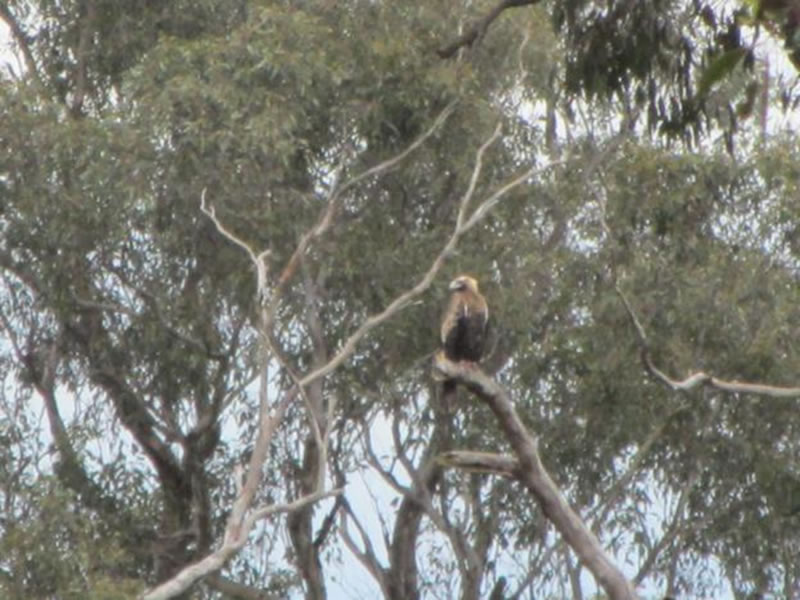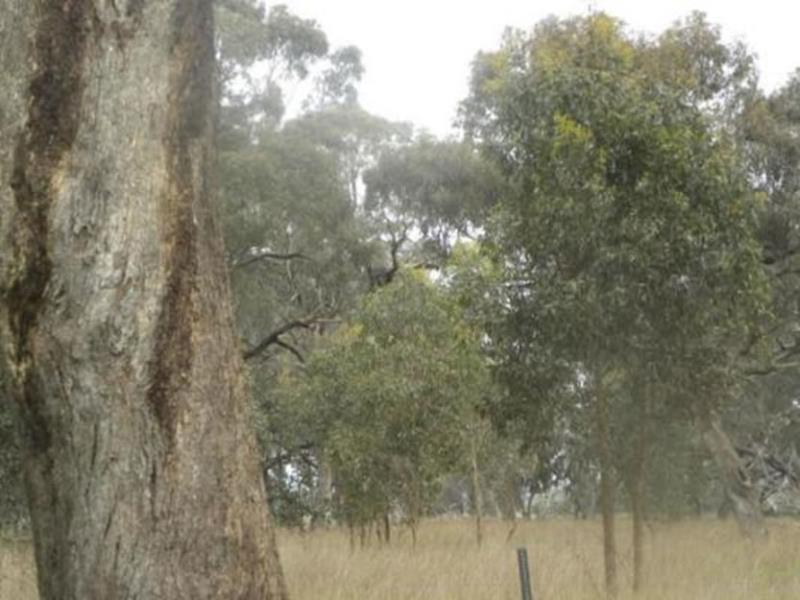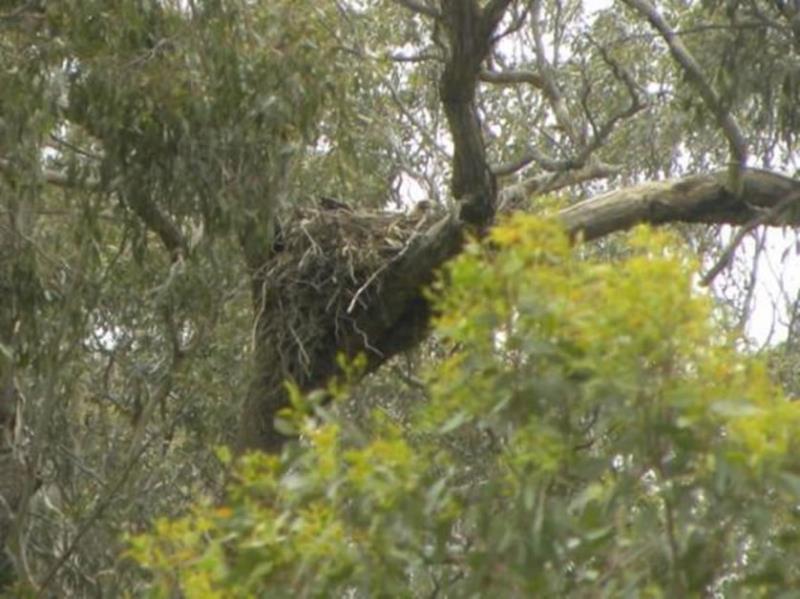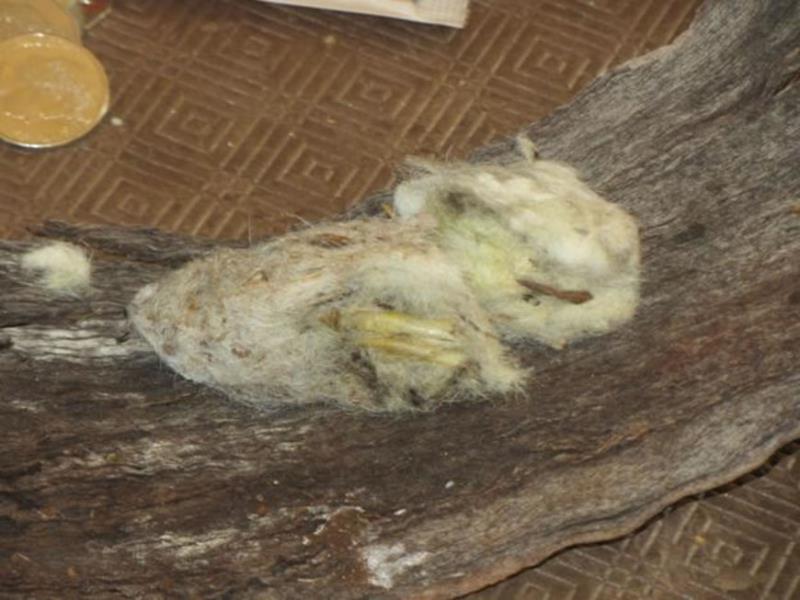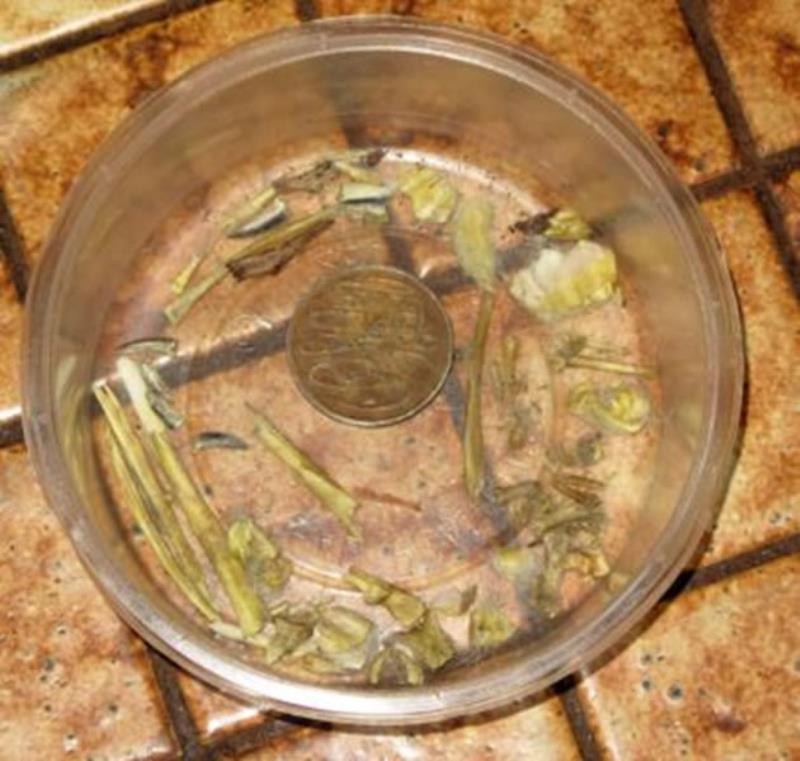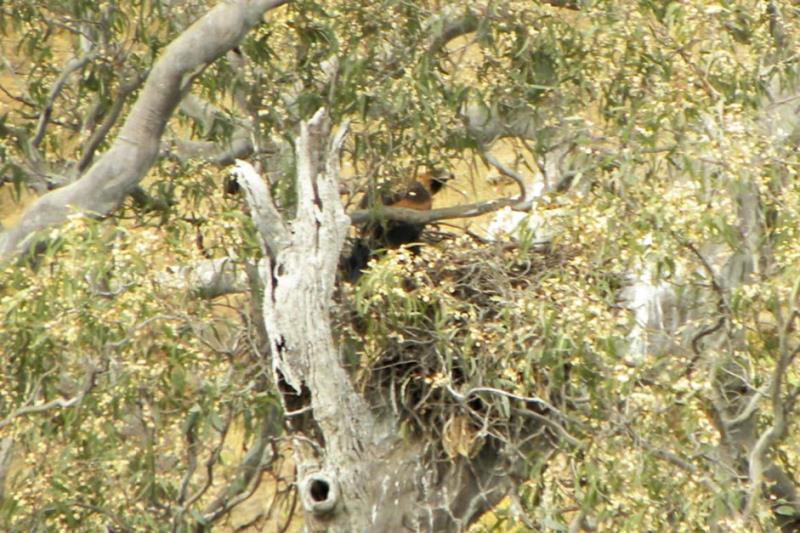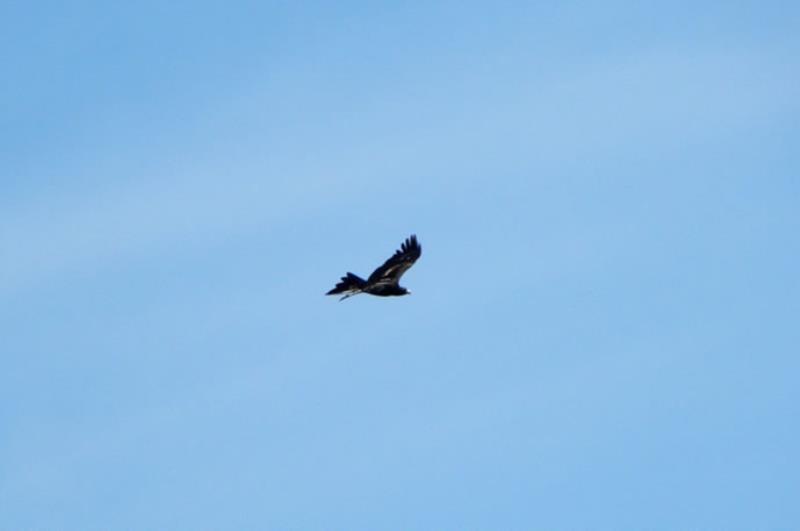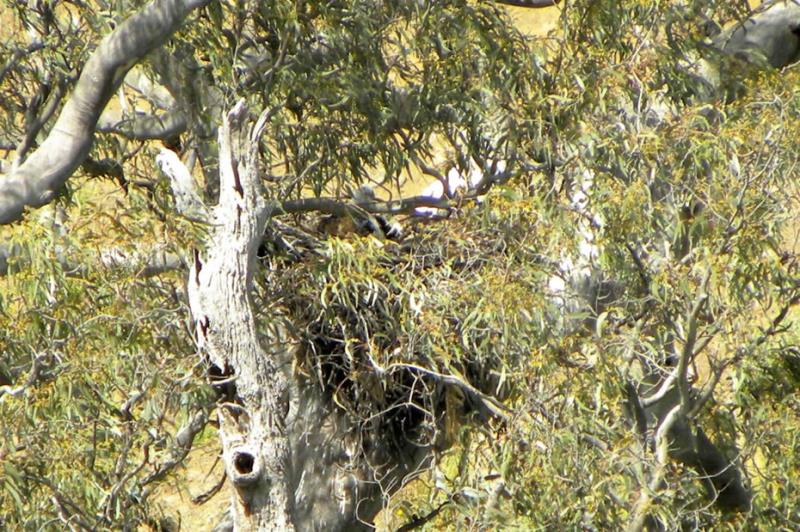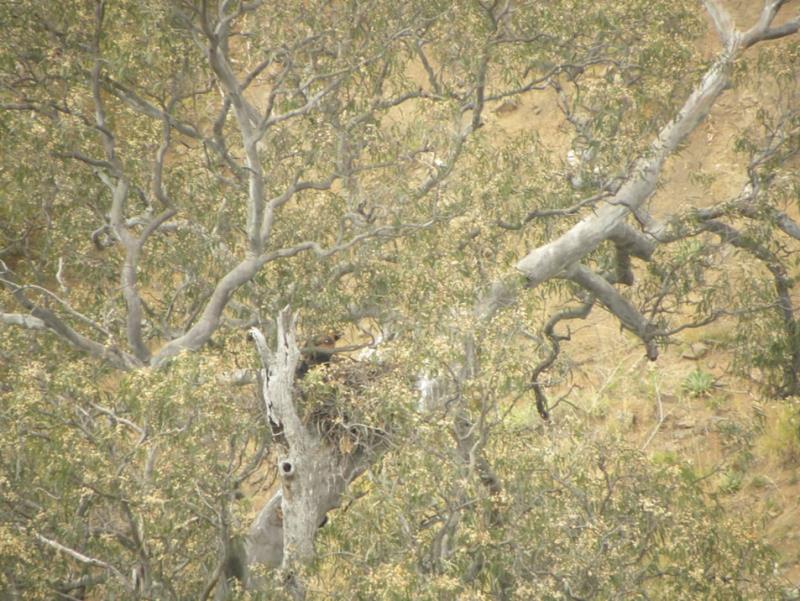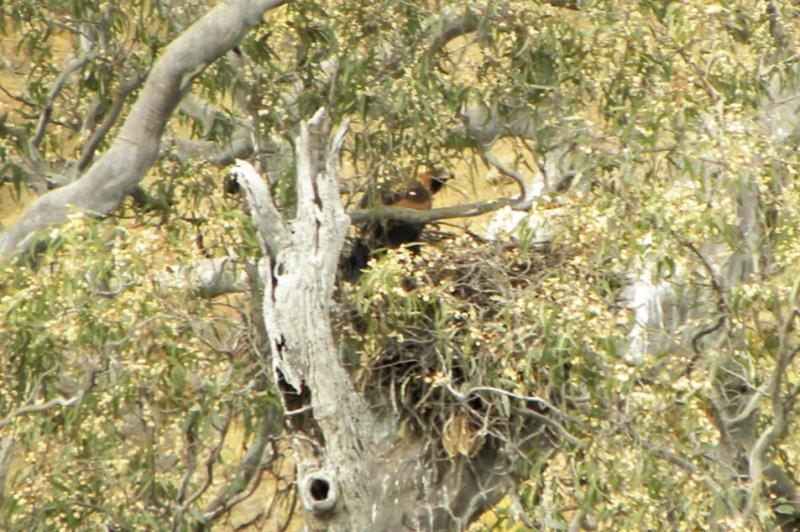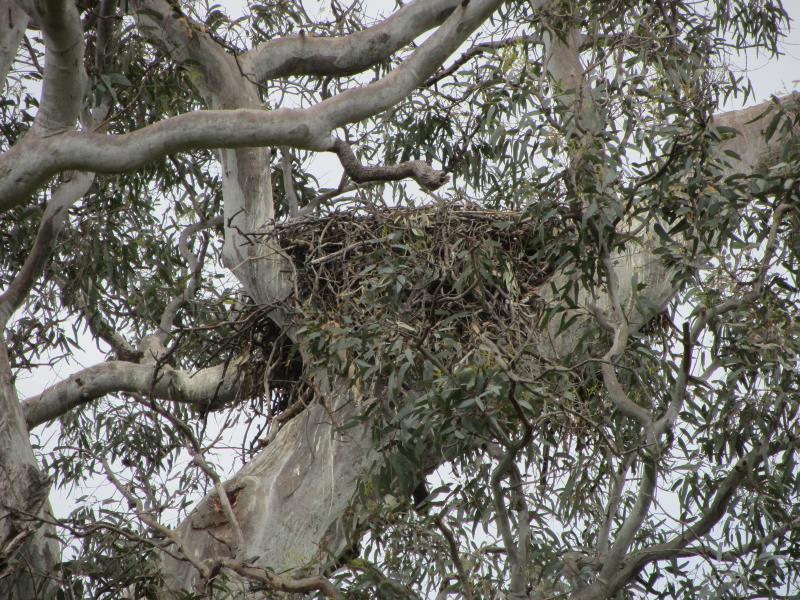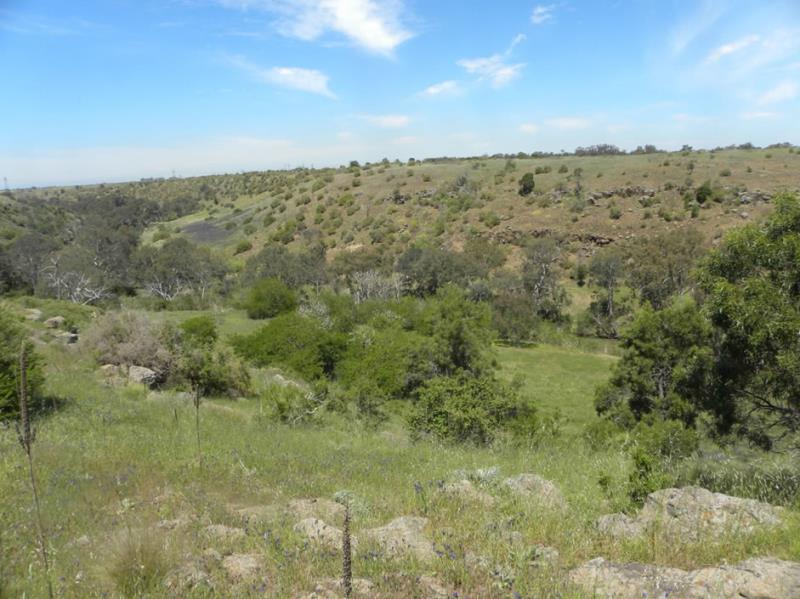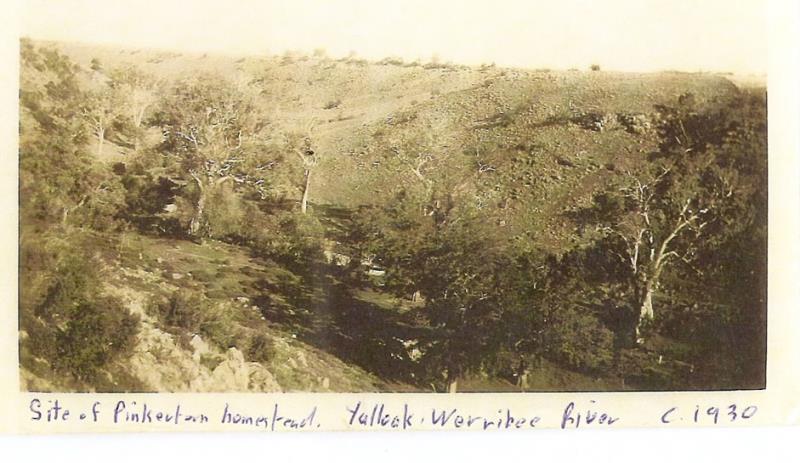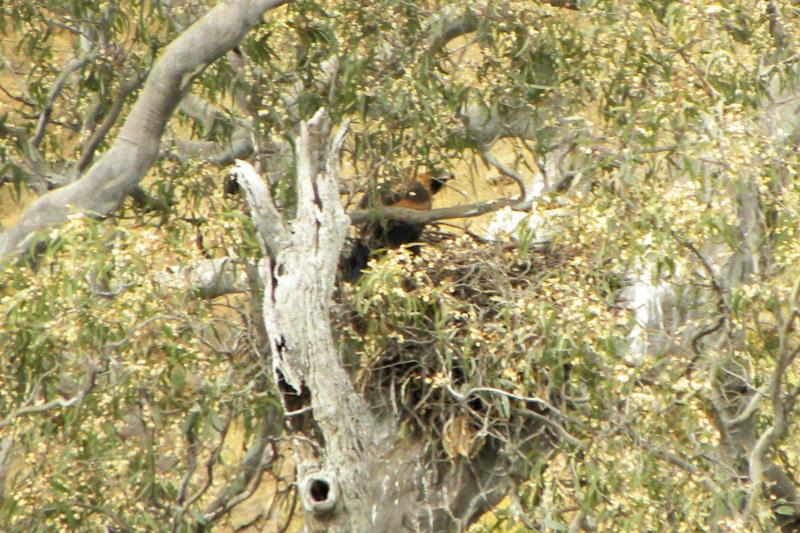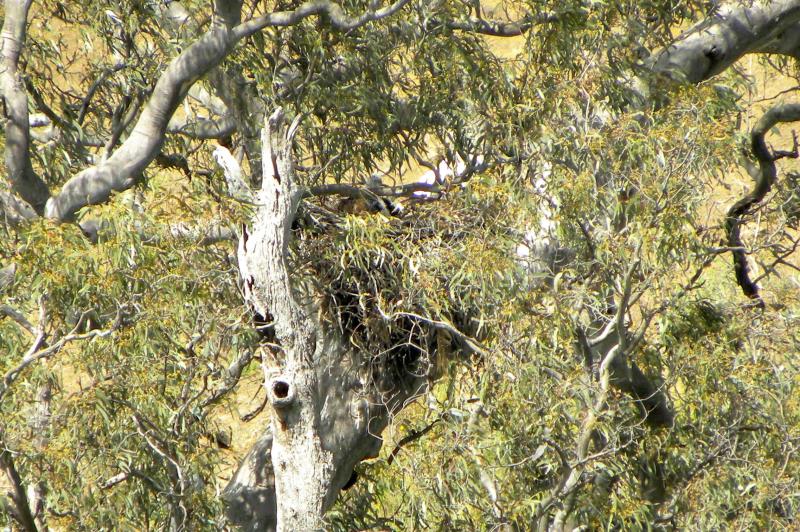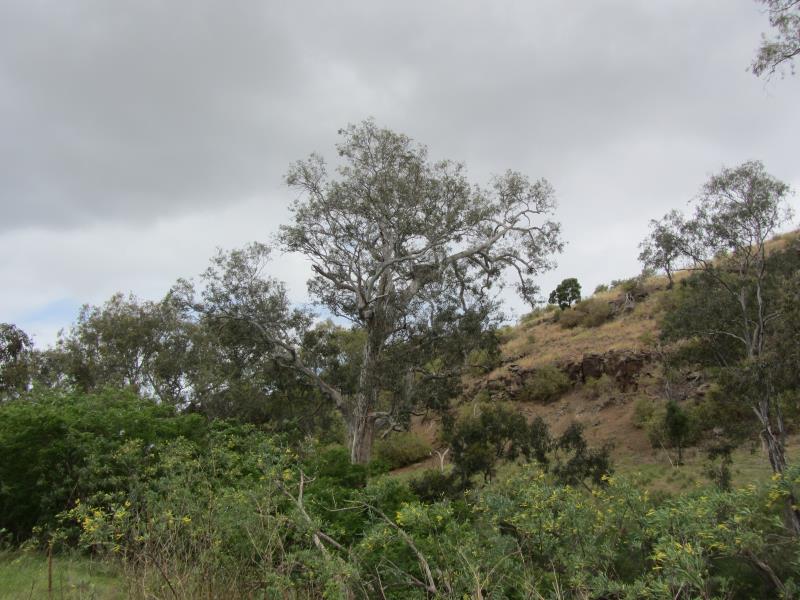In September 2012 a pair of Wedge-tailed Eagles were observed at the site where a pair of Wedge-tailed Eagles had successfully nested in 2007.
On Sunday 9th September 2012 PLEG members were checking on the progress of sheep grazing in Pinkerton Forest. The sheep had previously spent a week or so grazing in Lower Pinkerton Forest. We saw a Wedge-tailed Eagle take off from the ground near the old nest site, hotly harassed by magpies.
Sunday 9th September 2012
In September 2012 a pair of Wedge-tailed Eagles were observed at the site where a pair of Wedge-tailed Eagles had successfully nested in 2007.
On Sunday 9th September 2012 PLEG members were checking on the progress of sheep grazing in Pinkerton Forest. The sheep had previously spent a week or so grazing in Lower Pinkerton Forest. We saw a Wedge-tailed Eagle take off from the ground near the old nest site, hotly harassed by magpies. We walked into the forest checking on grazing results. The sheep had eaten much of the young green annuals while avoiding the natives that flowered last year. Just what they were meant to do. Excellent results in fact.
Wedge-tailed Eagles nesting at Pinkerton Forest
Wedge-tailed Eagle roosting 20 September 2012
Wedge-tailed Eagle nest in Pinkerton Forest 19th September 2012
Closeup of Wedge-tailed Eagle on nest 15th October 2012
Cast pellet found beneath eagle’s nest 9th September 2012
Small bones, claws and teeth in cast pellet found beneath eagle’s nest
Juvenile wedge-tailed Eagle on nest beside Werribee River 2014
Adult Wedge-tailed Eagle over Werribee River
Juvenile Wedge-tailed Eagle at Western Water 4th November 2013.jpg
Juvenile Wedge-tailed Eagle at Western Water 3rd January 2014
Close-up of juvenile Wedge-tailed Eagle at Western Water 3rd January 2014
Wedge-tail Eagle nest at pinkerton flat closeup from below - 9 nov 2012
Wedge-tailed nesting site beside Werribee River 2013
Same site photographed by AJ Campbell about 1930
Wedgie chick Pinkerton Flat 3rd Jan2014
Wedgie nest Pinkerton homestead 4th Nov 2013
Eagle nest Pinkerton flat from below (closeup) - 9th Nov 2012
We found ourselves under the old Wedge-tailed Eagles' nest, noting the amount of whitewash beneath it. A pair of Wedge-tailed Eagles had successfully nested here in 2007. After about five minutes there was a loud flapping sound and a huge black female Wedge-tailed Eagle took off from the nest! The female bird had allowed us to walk to beneath the nest tree and remained there for about five minutes as we stood beneath. We had both observed the nest as we approached but there was no bird visible. We immediately left the forest, to hopefully avoid disturbing the birds further and hoping we had not driven them from the nest.
The circumstance of the Wedge-tailed Eagle allowing us to approach a nest tree, and then remain for some time before flying off, was odd to say the least. Very strange that she stayed on the nest as we walked into the forest. She must have been sitting on eggs as we approached. When the original pair of Wedge-tailed Eagles nested here in 2007 they would leave the forest as soon as we entered the lane from Mt Cottrell Road, over a kilometer away! Perhaps this bird was used to the farmer regularly checking on the sheep. There didn’t seem to have been any changes or additions to the old nest; it looked the same as it had for several years. The lambs were quite large and the presence of the nesting eagles would have been of no consequence to the sheep grazing below.
As we were driving back along the lane, we could see both birds had returned and were circling around the nest area.
Western Water management and Pinkerton Landcare and Environment Group were notified so that arrangements could be made to avoid disturbing their nesting. Peter Gibbons (Pinkerton Landcare and Environment Group’s bird expert) and William Rajendram (Western Water Environmental Engineer) almost immediately replied stating that we hold a meeting at the earliest opportunity to develop a protocol/ procedure concerning forest management, given the presence of the birds. William suggested this meeting should also include the environmental contractor.
Note re. Conservation grazing in Pinkerton Forest
Conservation grazing by sheep is regularly used in both Pinkerton Forest and the neighbouring Bush’s Paddock as part of conservation management. Both grazing and burning, at strategic times and areas is used for weed control, biomass reduction, enhancement of biodiversity and reducing risk of wildfire. Grazing removes the exotic annuals as these are more palatable to the sheep than the native perennials. The farmer stated that the grass is most palatable and most nutritional when it is lush and fresh. Grazing is also a useful means of reducing fire danger. The availability of fresh lush grass reduces the likelihood that the sheep will graze on native shrubs and regenerating tree sapling regrowth.
About 150 ewes with lambs had been grazing in Lower Pinkerton for a few weeks, in late August. Toward the end of August they were removed to Upper Pinkerton.
About 5th September they were removed for shearing. This would have involved farm staff on 4 wheel farmbikes, with dogs (to ensure all lambs were found), on several occasions ie. some considerable human activity and noise. The eagles were obviously used to the sights and sounds of farming activities and so did not appear concerned.
A CFA burn in April 2012 of about half of Upper Pinkerton had removed most grass cover in the burnt area, resulting in heavy growth of annual grasses. Subsequent grazing removed the exotic annuals, removing competition from native perennials.
Thursday 20th September 2012 8.30
Environmental contrtactors were advised of the presence of the eagles so they would be mindful of the nesting eagles in Lower Pinkerton. Their presence there for a day hopefully should not unduly disturb the nesting eagles. Their plan of returning there at roughly monthly intervals to keep up with weed management also appears to be the best way to avoid disturbing the birds. Management disturbance in Lower Pinkerton would be minimal until the young birds had left the nest.
The bird was still at the nest, being harassed by Magpies. It was perched near the nest, casually watching us and looking around the forest. It didn’t seem unduly concerned about our presence.
October
However, by October it was apparent that the eagles had abandoned. Broken egg remains were seen beneath the nest. There had been a strong storm at the end of September so perhaps the egg had blown out or become chilled. Unfortunately the failed nesting remains a mystery.
Wedge-tailed Eagles nesting at Pinkerton Forest 2012
Wedge-tailed Eagle nest in Pinkerton Forest 19th September 2012
Closeup of Wedge tailed Eagle on nest 15th October 2012
Cast pellet found beneath eagle nest 9th September 2012
Small bones claws teeth in cast pellet found beneath eagles nest
Eagle nest Pinkerton flat from below 9 Nov 2012
Eagle nest Pinkerton flat from below (closeup) - 9th Nov 2012
Wedge-tailed Eagles nesting at Western Water 2013 - 2014
In 2013 a pair of Wedge-tailed Eagles nested beside the Werribee River at Western Water.
April 2013
In April 2013 during a Western Water staff walk in Pinkerton Forest the group observed a pair of White-bellied Sea-eagles in a tree beside the nest tree in which they had successfully nested in 2009 and 2010, raising a total of three chicks. Everyone had high hopes that the sea-eagles would once again nest in Pinkerton Forest.
Spring 2013
However, by spring, a pair of Wedge-tailed Eagles was noticed hanging around Pinkerton Forest and Bush’s Paddock woodland area. They seem to have assumed ‘ownership’ of this area, presumably after having displaced the sea-eagles.
Throughout spring they were constantly observed in and around Pinkerton Forest and Bush’s Paddock woodland area. They were seen even more often in Werribee River Volcanic Gorge or flying from the gorge during restoration work. Their activities seemed to be centred on the river.
There has been a nest here for some time, beside the Werribee River
November
On Friday 1st November, photos were taken of the nest. The photos were inconclusive.
On Monday 4th November, Frances and Daryl observed the nest from the top of the eastern escarpment, looking down into the nest. Photos taken seem to confirm presence of a young bird on the nest.
Positive confirmation of eagle chick on the nest.
On Tuesday 5th November Nora and Daryl returned to the nest for positive confirmation of nesting. A juvenile eagle chick was plain to see, sitting on top of the nest. In the sunlight fresh gum leaves could be seen lining the nest.
Positive confirmation of Wedge-tailed Eagles nesting at Western Water.
Wedge-tailed Eagles nesting at Western Water 2013 - 2014
Adult Wedge-tailed Eagle over Werribee River
Juvenile Wedge-tailed Eagle at Western Water 4th November 2013
Juvenile Wedge-tailed Eagle at Western Water 3rd January 2014
Closeup of juvenile Wedge-tailed Eagle Western Water 3rd January 2014
Wedge-tailed nesting site beside Werribee River 2013
Same site photographed by AJ Campbell about 1930
January 2014
After the presence of the juvenile Wedge-tailed Eagle on the nest we avoided further disturbance. Subsequent working visits to the river confirmed the presence of eagles in the vicinity.
On Friday 3rd January 2014 we returned to the river to water the plants we had planted here in Spring 2013. We decided to check the nest again. Two eagles immediately rose from the gorge and soared into the sky above our heads. As we approached to site overlooking the nest the juvenile birds was immediately visible but on our arrival it hopped to the opposite side of the nest, obscured from our view by foliage. It was now resplendent in juvenile plumage, with golden shoulders and head, with the rest of the body, including the face, a dark chocolate colour. This was a contrast to the dark, almost black parents.
2014
In February of 2014 the juvenile eagle was seen at several sites at Western Water. It was immediately recognisable in its juvenile plumage, with golden shoulders and head, with the rest of the body a dark chocolate colour. It was usually disturbed while perched on the ground.
